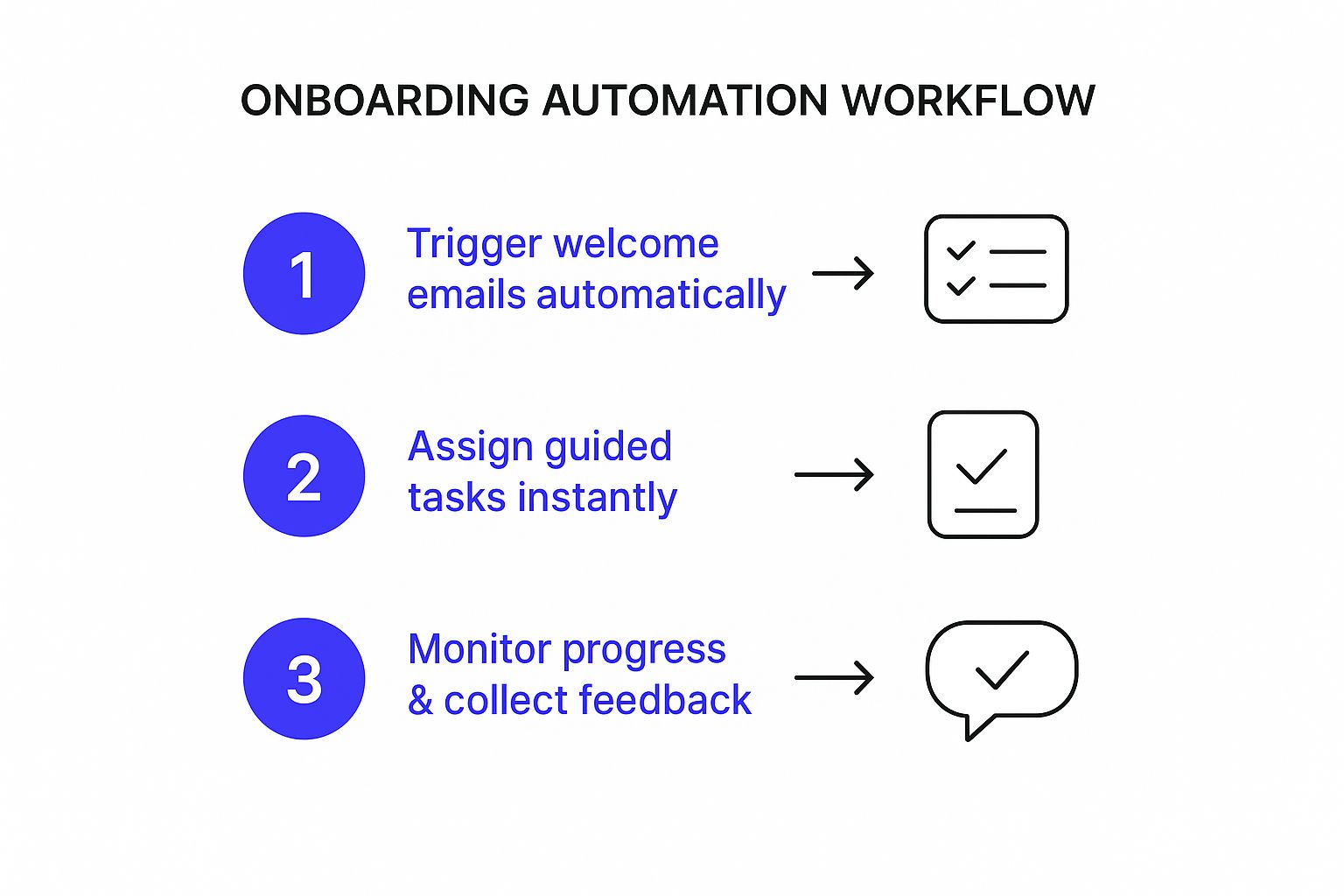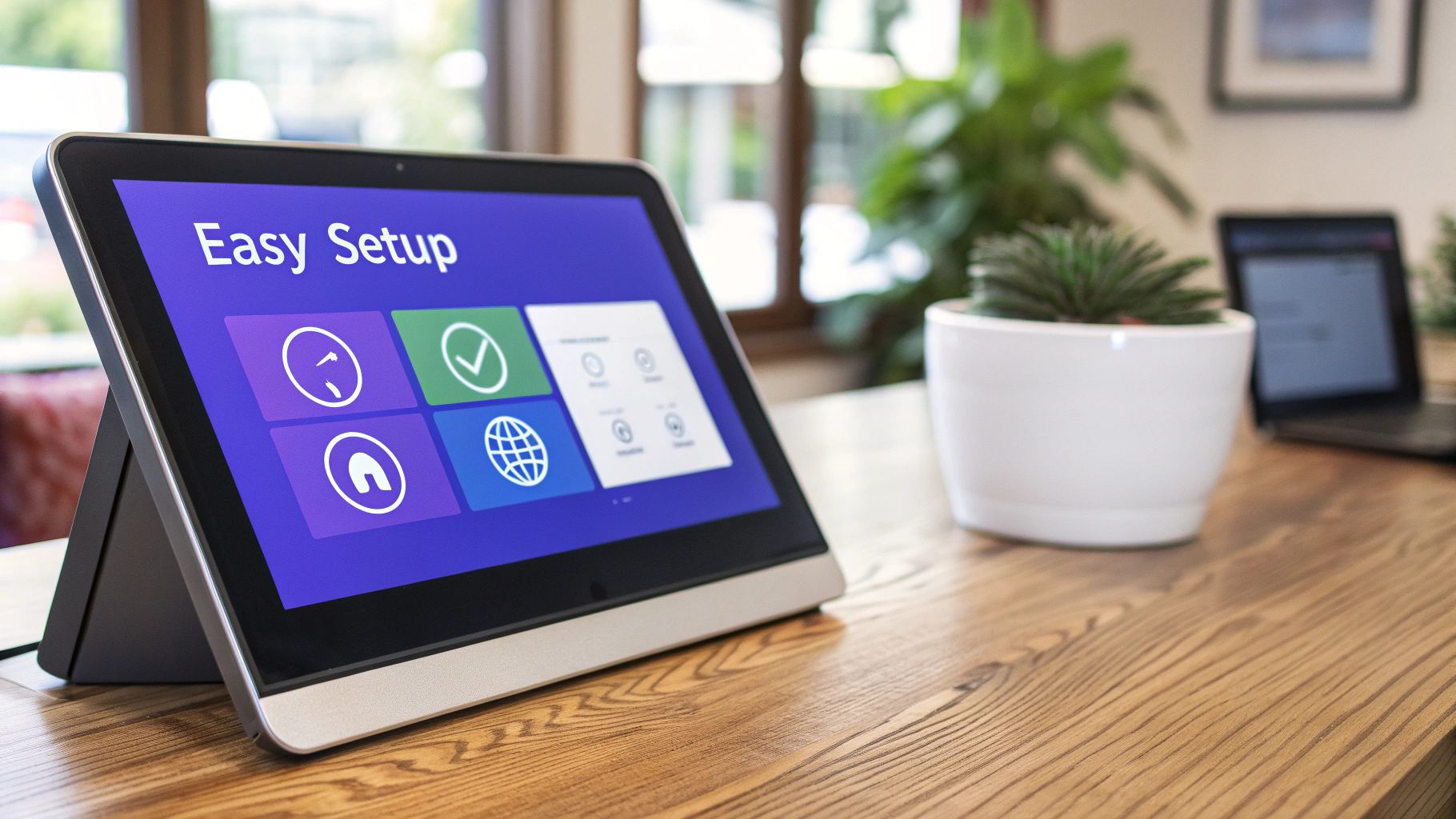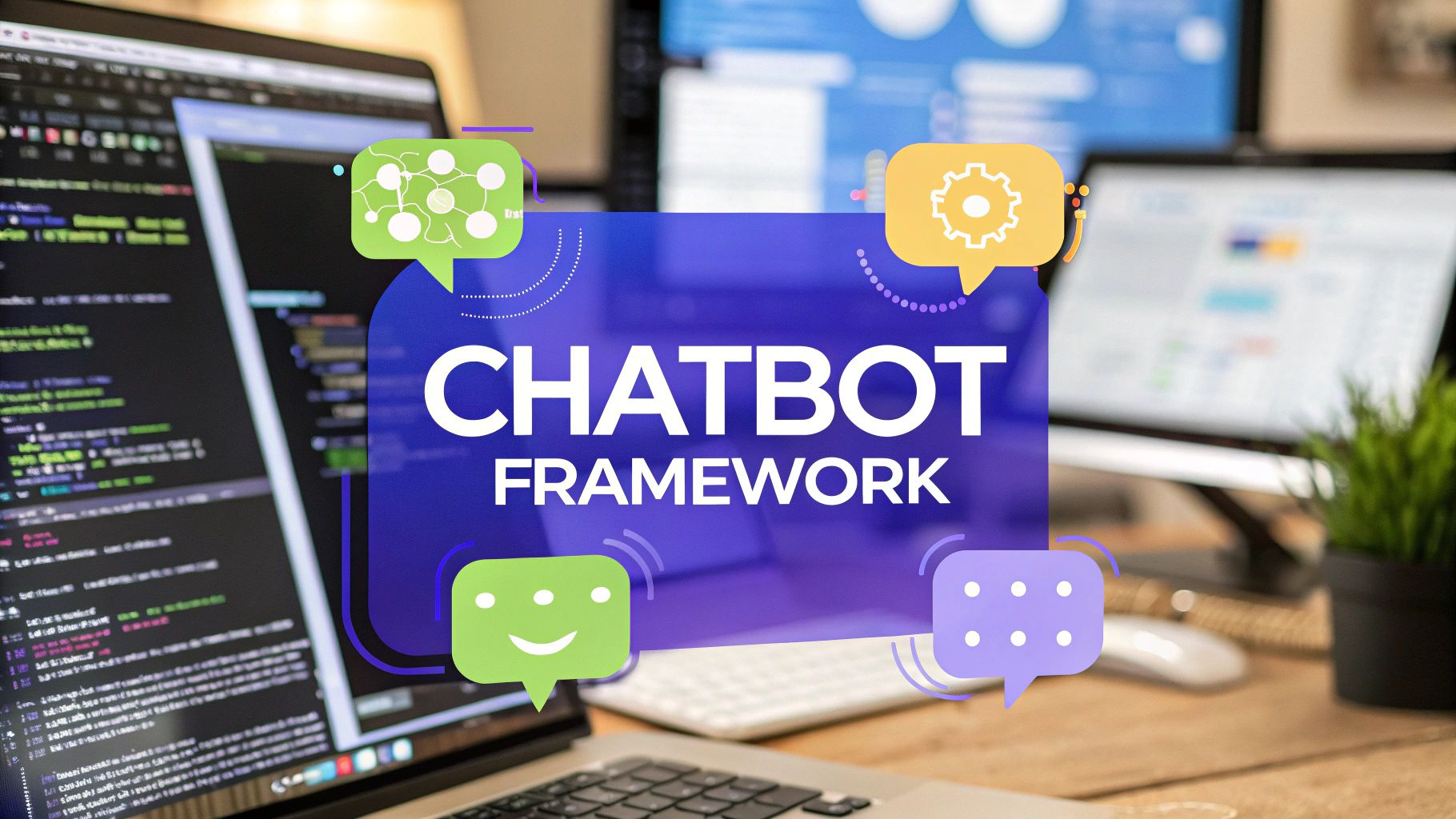Customer Onboarding Automation: Boost Engagement Today
Learn proven customer onboarding automation strategies to streamline processes and retain more clients. Start transforming your onboarding now!

Why Your Onboarding Is Probably Broken (And You Know It)
Let's be honest, most onboarding experiences feel like trying to assemble flat-pack furniture without the instructions. You're excited to build that new bookshelf, but the process leaves you confused and frustrated. This isn't your fault; it’s a design flaw. Companies often try to cram every single feature into the onboarding process instead of helping users achieve that first quick win. They overload you with information instead of crafting a helpful experience.
Think about your own experiences. How many times have you signed up for a cool new app, only to be bombarded with emails, tutorials, and notifications that left you feeling lost? This isn’t just annoying; it’s bad for business. A clunky onboarding process can drive users away before they even get a chance to see how great your product is. You're investing in acquiring customers, but you’re losing them at the starting gate.
First impressions are everything. You have a short window to show users the value of your product and build trust. If your onboarding feels like a chore, they'll abandon ship faster than you can say "unsubscribe." In fact, 90% of users will abandon a product due to poor onboarding. Discover more insights about user onboarding statistics. This isn't just a number; it's a wake-up call for businesses to rethink their entire onboarding strategy. Onboarding isn't just about registration anymore; it’s a crucial, data-driven journey that directly affects how long users stick around.
Signs Your Onboarding Needs an Overhaul
Here are some red flags that your current onboarding process might be doing more harm than good:
- High churn rate in the first week: Are users disappearing almost as soon as they sign up?
- Low feature adoption: Are users struggling to grasp the core functions of your product?
- Tons of support tickets: Are you drowning in basic "how-to" questions?
- Negative feedback during onboarding: Are users voicing their frustration in surveys or reviews?
If any of these sound familiar, it’s time to admit that your onboarding isn't just inefficient; it’s actively holding you back. Don't just try to fix the small problems—reimagine the whole thing. Focus less on telling users what to do and more on guiding them. With tools like Chatiant, you can transform your onboarding from a weakness into a strength by creating personalized, automated experiences that deliver value from the very first interaction.
The Gap Between Knowing And Actually Doing

Everyone's buzzing about customer onboarding automation. It's the holy grail of happy customers and productive teams. But here's the thing: so many companies get bogged down in the planning stage, never actually reaching that automated paradise. They know the theory, but putting it into practice? That's a whole other ball game.
I've seen this firsthand. Companies often underestimate how much goes into successful automation. It's not a set-it-and-forget-it solution. It takes careful planning, meticulous execution, and constant tweaking to get it right. Another trap I've seen is trying to automate everything from the get-go. Trust me, it's better to start small, focus on the most impactful parts of your onboarding, and gradually expand from there. Trying to do everything at once just leads to burnout and frustration.
Resources are another sticking point. Teams often lack the time, money, or know-how to implement automation effectively. That's where prioritizing and picking the right tools, like Chatiant, become so important. You don't need a huge budget to start automating. You need a smart strategy that focuses on getting the most bang for your buck with the resources you already have.
There's a real disconnect between seeing the need for customer onboarding automation and actually doing it. A 2025 study found that while 93% of organizations see automation as key for future onboarding success, only 25% have fully automated their processes. It's a stark reminder of how tough it can be to turn ideas into action. Discover more insights on the future of customer onboarding. This gap highlights the demand for practical guidance and tools that help businesses bridge that divide.
Bridging the Gap: Practical Strategies
So, how do you go from knowing to doing?
- Start with a clear vision: What are you hoping to achieve with automation? Set specific, measurable goals.
- Prioritize quick wins: Don't try to do everything at once. Target the areas that will give you the biggest return on your effort.
- Choose the right tools: Platforms like Chatiant offer powerful yet user-friendly automation features that fit realistic budgets.
- Build internal momentum: Get your team excited by showing them the benefits and celebrating early wins. This keeps everyone motivated.
- Iterate and optimize: Automation is an ongoing journey. Continuously test, refine, and improve your workflows based on real data and feedback.
By tackling these challenges head-on, you can finally close the gap between knowing and doing, and unlock the true power of customer onboarding automation. It's time to move from theory to practice and build the onboarding experience your customers deserve.
Building Your First Automated Flow That Actually Works

This infographic shows a simplified customer onboarding automation workflow. Think of it as a welcome mat, a quick tour, and a nudge in the right direction, all rolled into one smooth process. This streamlined approach makes onboarding feel effortless for your customer and frees up your team's time.
Let's move from theory to practice and build a real automated flow using Chatiant. Instead of getting bogged down in technical details, we'll focus on the customer. What's their experience like right after signing up? What are their initial hurdles? How do we know if they're succeeding?
Mapping the Customer Journey
Imagine onboarding new users for a project management tool. A basic flow might look like this:
- Trigger: New user starts a free trial.
- Action 1: A personalized welcome email from Chatiant, emphasizing the benefit of quick organization.
- Action 2: An in-app Chatiant chatbot message pops up, offering a guided tour of the main features.
- Action 3: After the tour, Chatiant automatically assigns a first task: creating their initial project.
This simple example demonstrates the potential of automation. Each step builds on the last, guiding the user through those crucial first interactions with your product.
Setting Up Triggers and Actions
Chatiant offers the flexibility to set up these triggers and actions easily. You define the events that kick things off, like a new signup or a completed profile. Then, you choose from a variety of actions, like sending emails, triggering chatbot messages, assigning tasks, or updating customer data in your CRM. The possibilities are vast, letting you create a tailored onboarding experience.
Personalizing the Experience
A common mistake is treating all customers the same, even with automation. Personalization still matters. Chatiant lets you segment users based on their needs, their actions, or the plan they chose. This allows you to create tailored messages and guidance that resonates with each group. The goal is to make automation feel more human.
Before we dive deeper into building flows, let's compare some popular onboarding automation platforms:
To help you choose the right tool for your needs, here's a quick comparison of a few popular platforms:
Essential Onboarding Automation Tools Comparison:A comprehensive comparison of popular onboarding automation platforms, their key features, pricing, and best use cases.
This table highlights some of the leading platforms for onboarding automation, each with its strengths. Choosing the right one depends on your budget and specific needs. Consider which features are most important to you and which platform best aligns with your overall customer communication strategy.
Finding The Sweet Spot Between Automation And Human Touch

So, you've built your automated onboarding sequence. Great! But now comes the real magic: blending that automation with genuine human connection. The most effective onboarding feels personal, like a helpful friend guiding you through the process, even when it's working efficiently with thousands of users. It's not about picking one or the other—it's about weaving them together seamlessly.
Think about it: a customer is wrestling with integrating your product with their current CRM. A pre-written email might offer some basic troubleshooting, sure, but a quick, proactive check-in from a real person? That's game-changing.
That personal touch can transform a potentially frustrating experience into a positive one. It shows the customer you genuinely care about their success.
User segmentation is key here. Let's be real, not everyone needs the same level of hand-holding. Customer onboarding automation lets you pinpoint those users who could benefit from a little extra attention. Maybe they're brand new to this type of software, or their setup is a bit more complex. A short, personalized message from your team can build rapport and increase their chances of sticking around.
This balance of automated efficiency and human interaction has a real impact. Hybrid onboarding models boast a 73% satisfaction rate, nearly double the 41% seen with digital-only approaches. Even more telling? 78% of users actually prefer at least one live interaction during onboarding. Discover more insights about user onboarding statistics. This underlines the importance of finding that sweet spot. Automating isn't enough; you need to connect, too.
Making Automated Touchpoints Feel Human
Even automated messages can have a personal touch. Here's the secret sauce:
- Use a conversational tone: Scrap the robotic language. Write like you're chatting with a friend over coffee.
- Personalize messages: Use the customer's name and tailor the content to their specific needs or industry. Maybe something like Chatbot Conversation Flow Design could help.
- Offer genuine help: Instead of generic advice, offer concrete, actionable tips relevant to their particular situation.
- Empower your team: Equip your customer success team to step in when necessary, armed with all the context your automated systems have gathered.
By focusing on the human element, even automated touchpoints can build trust and cultivate long-term customer loyalty. The goal is to use automation to improve the human experience, not to replace it. This creates a powerful combination that boosts customer satisfaction and operational efficiency.
What SaaS Companies Know About Onboarding Excellence
Let's talk SaaS onboarding. These companies live and breathe it – their whole business model depends on keeping customers engaged and subscribed. Out of pure necessity, they’ve become masters, and there’s a goldmine of wisdom we can tap into.
One thing successful SaaS companies get is that automation isn’t about replacing human interaction. It’s about making it better. They use it to create personalized experiences at a scale that wouldn’t be possible otherwise.
This shift towards value-focused onboarding is a game-changer. Instead of tedious feature tours, they show users how to get quick wins. They know a new customer isn’t interested in every single button; they want to solve their problem – fast. This upfront value demonstration translates to much higher retention rates.
Leading SaaS businesses also understand the economics of customer acquisition vs. retention. It's way more expensive to get a new customer than to keep an existing one. That's why they prioritize onboarding automation to maximize customer lifetime value. Nurturing customers from the start builds loyalty that lasts.
This SaaS focus on onboarding automation reflects a larger trend. By the end of 2024, the global SaaS market was valued at a staggering $317.55 billion, with 90% of IT professionals viewing automation as essential. Want more stats on SaaS onboarding? Check out this blog post.
Adapting SaaS Strategies to Your Business
Even if you're not selling software, these SaaS principles are still gold. The core ideas – value-focused onboarding, personalized automation, and prioritizing retention – apply across the board. Think about automating key touchpoints to create a smoother, more engaging welcome for your customers. An AI chatbot for customer service can really boost your approach, too. Whether you're selling shoes or offering consulting services, the principles hold true.
Here's what we can learn from the SaaS onboarding masters:
- Focus on value, not features: Show the core benefit of your product or service right away.
- Personalize the experience: Use data and segmentation to tailor onboarding to each customer's needs.
- Measure what matters: Track key metrics like customer lifetime value and retention rates to see how your onboarding efforts are performing.
- Embrace the hybrid approach: Combine the power of automation with the personal touch of human interaction. It's the best of both worlds.
- Continuously optimize: Regularly review and improve your onboarding process based on data and customer feedback. It's an ongoing journey.
By using these strategies, you can create an onboarding experience that not only welcomes new customers but also sets the stage for long-term success and loyalty. This is how smart companies transform onboarding from a required step into a real competitive advantage.
Measuring What Actually Matters For Success

So, you've poured your heart and soul into crafting these amazing automated onboarding flows. But how do you know if they're actually making a difference? It's easy to get caught up in tracking vanity metrics. You know, those numbers that look impressive on a report but don’t tell the real story – like how many emails you blasted out or how many users clicked a button. Those might make you feel good momentarily, but they don't necessarily translate to happy, engaged customers.
Instead, let's focus on the metrics that really move the needle – the key performance indicators (KPIs) that truly reflect the success of your customer onboarding automation. This means looking beyond surface-level clicks and delving into what drives long-term customer value and happiness.
Identifying Your True North Star Metrics
Just like every business is unique, so are the KPIs you'll want to track. However, some core metrics generally apply to most customer onboarding automation efforts. Think of these as your North Star, guiding you toward onboarding success.
- Time to Value (TTV): This is a big one. How long does it take a new customer to experience the core value of your product or service? A shorter TTV usually translates to quicker adoption and higher satisfaction.
- Customer Lifetime Value (CLTV): How much revenue can you expect from a customer throughout their entire journey with you? Effective onboarding plays a crucial role in maximizing CLTV.
- Customer Churn Rate: This one stings. What percentage of your customers cancel their subscriptions or abandon your product/service? A high churn rate, especially early on, can point to onboarding friction.
- Feature Adoption Rate: Are your customers actually using the key features you built? Low adoption rates might signal confusion or a mismatch between their needs and your product’s offerings.
Tracking these metrics gives you a much richer understanding of your onboarding effectiveness than vanity metrics ever could. It allows you to make data-driven decisions about where to invest your optimization efforts. You might be interested in reading more about best practices for help desk support: Top Best Practices: Help Desk for Enhanced Support in 2025.
Speaking of metrics, I've put together a handy table to help you visualize what to track and how to interpret the data. It includes some industry benchmarks and tactics to boost your numbers.
I've put together a table to help you visualize what to track and what the data means. It includes some industry benchmarks and even a few ideas on how to move the needle.
Onboarding Metrics That Actually Matter: Key performance indicators for measuring onboarding success, including benchmarks and improvement strategies
This table highlights the key metrics, what they represent, and some general benchmarks. Remember, benchmarks vary across industries, so do some research to find what's relevant to your specific niche.
Building a Culture of Continuous Improvement
Measuring your KPIs is just the starting point. The real magic lies in using that data to iterate and improve. This means experimenting with different approaches and refining your strategy based on what you learn.
Here are some actionable insights you can glean from your data:
- High TTV: If it's taking too long for users to experience value, perhaps your onboarding flow is too complex or doesn't focus enough on the immediate benefits. Simplify the process and highlight those quick wins.
- Low CLTV: This might suggest users aren’t engaging fully with your product. Try adding personalized follow-up messages, special offers, or additional training resources to deepen their engagement.
- High Churn Rate: Yikes! This is a serious warning sign. Dive deep into where users are abandoning ship and identify the friction points. You might need to tweak your messaging, beef up support, or even redesign parts of your onboarding flow.
By consistently analyzing your data and making informed tweaks, you build a culture of continuous improvement. This ensures your customer onboarding automation is constantly evolving and adapting to deliver the best possible experience. It's a journey, not a destination, and your data is your compass.
Your Action Plan For Onboarding Excellence
It's time to put all this great info into action! This roadmap breaks down customer onboarding automation into practical steps you can start using today. It doesn't matter if you're just starting out or working with a limited budget, we'll map out a plan and discuss common hurdles and how to overcome them.
Prioritizing for Maximum Impact
You absolutely don't need a huge budget or a dedicated team to start automating your customer onboarding. Begin by identifying the biggest pain points in your current process. Are simple questions overwhelming your support team? Is your churn rate alarmingly high in the first week? Focus your initial automation efforts on these areas to see the greatest impact. Small, quick wins are essential for building momentum. These initial victories demonstrate the value of customer onboarding automation and make it easier to get buy-in for future automation projects.
Budget-Conscious Approaches
Plenty of affordable tools and strategies deliver great results. Chatiant, for example, offers powerful automation features without a hefty price tag. Start by automating simple tasks like welcome emails, personalized messages, or basic in-app guidance. You might be surprised at how these seemingly small changes can improve your overall onboarding effectiveness.
Building a Sustainable System
As you become more familiar with automation, you can gradually expand your efforts. The key is to create a sustainable system that grows with your business. This involves documenting your workflows, training your team, and continuously testing and refining your approach. Avoid automating just for the sake of it. Every automated step should add value to the customer journey.
Troubleshooting and Maintaining Quality
You'll inevitably encounter challenges. Maybe an automated message isn't sending correctly, or user behavior isn't what you expected. Don't worry! Troubleshooting is a normal part of the process. Analyzing data and gathering user feedback can help you quickly identify and fix problems. Maintaining quality as you scale requires continuous attention. Regularly reviewing your automated flows and user feedback is essential for long-term success. This keeps your onboarding a strong point, even as your customer base grows.
Ready to give your customer onboarding a makeover? Explore Chatiant today and create the experience your customers deserve.


